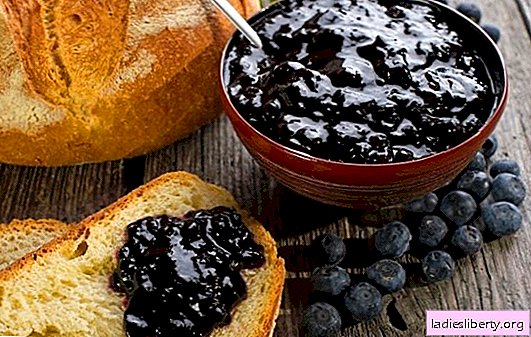
Gel Nail Coating at Home: Photos and Features
It seems that at home it is impossible to cover the nails with gel or gel polish.
A lot of equipment, education, skill and talent are needed.
In some ways you are right, nails covered with gel - this is an exhausting painstaking work.
Even a professional in the salon takes up to three hours to do this job.
But, despite all of the above, at home this work is feasible. Moreover, now it has become very fashionable for young girls to get everything they need and “make nails” at home without getting up off the couch.
There are several options for coating with gel or gel polish, such as for strengthening without building, on tips or on the form.
In cases where the shape and length of your nail is completely satisfied, but you want to make it less brittle and more durable, then use a gel or gel polish coating without extension.
Tips or shape are used to add extra length. As a rule, it is from 5 mm. up to 1 cm, but there are those who want to see nails up to 3 cm long on their fingers.
The method of applying both the gel and gel polish is practically no different from each other, only with some subtleties. A gel is a viscous substance that varies in color and purpose, and gel polish is a varnish, in which a gel is added for strength. They only dry out under the influence of a UV lamp. The gel is applied to the nail with a thicker layer, so that after drying, cut off the excess and give the nail a shape. Gel polish in this regard differs from its counterpart. It is applied in a thin layer, it is possible in several layers.

It turns out that the gel, as it were, simulates a nail, can give it any shape, it is denser, holds on to the nail more firmly and less often breaks off. Gel polish is inferior here. It cleaves, it is difficult for them to simulate the desired shape of the nail, to give a relief to the tuberosity. For that, it looks much more natural, it can hardly be distinguished from your nail.
Gel Polish at Home: Material and Tools
For a full and strong gel and gel varnish coating at home, it is necessary to prepare all materials in advance. Now it’s not uncommon to meet a specialized store selling material and necessary accessories for nail extension and correction, so the question is “where to buy?” does not occur.
As for the material, for applying a gel or gel polish, you must have:
• gel or gel polish;
• degreaser;
• primer;
• top coat;
• nail file;
• buff for polishing;
• orange sticks;
• lint-free napkins or cotton pads;
• cuticle oil;
• UV lamp.
To coat with gel polish, you need to have not only color, but also a special transparent coating for basic and finish application. They can be either individually or 2 in 1. Naturally, the acquisition of funds that combines two functions saves both money and space in the locker.
With regards to tools, you should not think that you will manage one file here. There should be at least three: with fine and large abrasiveness plus buff for polishing the surface of the nail. Abrasiveness - this is the degree of rigidity, measured in grit. The higher this indicator, the less dusting and the softer the nail file. For artificial nails, it is usually from 100 to 180 units, and for natural ones from 180 and above. Everyone has their own preferences for the material of the nail file, but if you think about it, then it's better to choose plastic ones. They are stronger than paper, more flexible than glass, and at a price more profitable relative to laser and ceramic files.

The degreaser can be replaced with simple pharmacy alcohol, but all other materials cannot be replaced or eliminated.
Gel Nail Coating at Home: Procedure
In order for the coating, whether gel or gel polish, to last long and not obscure the joy of wearing a permanent manicure with chips or detachment, you need to follow simple rules.
After you have acquired everything you need in order to cover the nails with gel at home, you need to catch the sequence of actions.
The first step is to prepare the nail plate. To do this, the cuticle is pushed away with orange sticks and the nail surface is cleaned with a nail file so that it becomes dull. The nail is shaped. A slight difference in preparation is that under the gel the surface is smoothed out with larger abrasiveness (190 grit), and under the gel polish only the glossy layer is removed, so you can use a 220 grit abrasive file. But if you have only one, then approximately 200 grit is suitable for one coating and for another.
At this stage, you need to decide whether you want to get an extra length or just strengthen the existing one. If the second option, then go to the second step, and if the first, then there are two options. Do this using tips or form. Tips are glued with special glue, their surface is grinded flush with the nail, shape and length are selected. If you use the form, then you need to install it under the nail, and make the gel coating to the required length.

The second step is to apply the primer.. It should be noted that it is not advisable to hit it on the tips, so you need to apply it strictly to your nail, without touching its artificial part. After the primer dries, a base gel is applied (if it is a three-phase gel scheme) or constructing (if it is a two-phase scheme).
Exists several gel coating options it is three and two phase. In the first embodiment, the base layer of the gel is first applied to the nail after the primer, and then the main (constructing) and finishing layer. Each layer is dried under a UV lamp. The difference between the two-phase system is that the main gel contains a base gel, as it were, 2 in 1. This greatly simplifies the task and saves time.

The design gel is applied as many layers as necessary to give the nail the desired shape and thickness. After it has completely dried, and this is about 3-4 minutes, the sticky layer is removed with a degreaser. A gel with a large abrasive forms the surface of the gel until it acquires a beautiful oval shape, symmetrical as a drop of water, frozen on a nail. If it seems to you that there is nothing superfluous, you still have to grind off. To apply the finish, the surface must be rough and matte.
Usually, finish gel more liquid consistency and is applied as varnish with a thin layer.
When coating the nail with gel polish, a transparent base gel is applied after the primer. It provides good adhesion to the nail plate. And only on the base gel, after it dries, color gel polish is applied. Further, everything is fastened with a finish coating.

Upon completion, a sticky layer is removed from the nail with a degreasing agent, and the cuticle and skin around the nail are treated with special oil.
It would seem that gel polish in comparison with gel makes nails stronger and less brittle, looks more natural and cheaper, but there is one minus. After the nail has grown and a correction becomes necessary, it turns out that the gel polish needs to be completely removed and applied again. This takes longer than gel-covered nails at home, which are easily correctable. For this, the overgrown part of the nail and the surface of the gel are grinded off, then the gel is applied according to the above scheme, as if filling voids and bumps.
Gel Polish at Home: Professional Tips
After the primer is applied, the nail should not be touched. Accordingly, touching and clinging to foreign surfaces is prohibited so as not to disturb the thin layer of the primer.
During the whole process, even at home, gel polish should not be accompanied by hand washing. Any minor moisture will be detrimental to the coating.
At the stage of preparation for the application of the primer should be very careful to grind the surface of the nail. Carefully remove any particles remaining on the cuticle and cut off, if any, the exfoliated edge of the nail. The surface should be uniform and dust free, then the coating will last as long as possible.
Primer on the nail is applied by rubbing movements from the center to the edge, and then vice versa. Ten minutes after drying, a second coat is applied. This is necessary so that he soaks the nail with himself. The principle of double adhesive tape works here, fastening the nail and gel together as tightly as possible. Therefore, you need to try so that the substance penetrates into all inaccessible places on the nail.
It is very important to strictly follow the rules and observe the technology of applying the gel on the nail without touching the cuticle and side rollers. Experts advise making a small indent from the cuticle, approximately 1-1.5 mm. This gap will not be noticeable to others, but it will provide you with confidence that you definitely haven’t hooked anything superfluous. If the gel still got on the cuticle, then you need to remove it from there at any cost, otherwise on the second day the coating will begin to peel off and it will have to be applied again.
When working with gel polish it is also important to observe the thickness of the layer. It should be very thin, almost transparent. The color in the first layers will lie unevenly, but it's not scary. The following layers compensate for hue and density. Let you have to apply three layers to achieve the desired result. It is very important that they are thin. It is better than two thick layers.
When applying gel polish in a thick layer, air bubbles and waves can appear on the surface, which is why it is so important that the layer is as thin as possible. Also of the required procedures is the coloring of the end of the nail. This is done in order to reduce the risk of edge delamination.

Another common mistake is the acquisition of gel coatings of different companies. This is when the finish and color coating of one manufacturer, and the base of another. It is believed that the substances developed in one company are ideally suited for each other, and if they differ, there is a risk that they will "conflict" with each other. This will lead to an early damage to the coating and to do all the work again.
Even at home, gel-coated nails, subject to all the rules and technologies, look like new and keep without chips and remnants for about a month.
Watch the skin of your hands, make a scrub and smear it with cream, because even the most beautiful and expensive manicure will not look on dry and rough hands.











